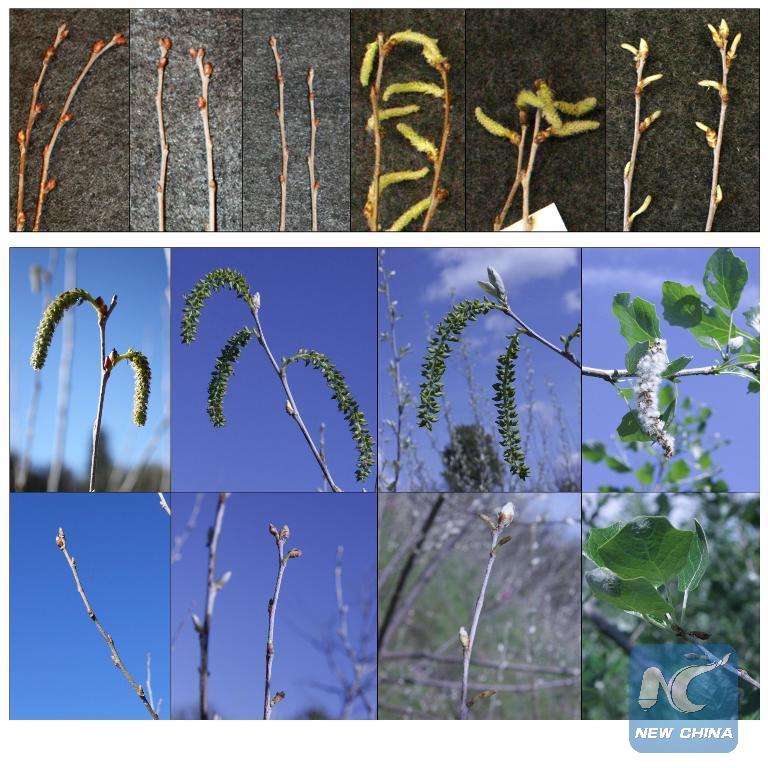
The top row: dormant buds collected in the field for initial examination in the lab. From left: buds from wild (control) trees; buds from an RNAi tree with a normal appearance; buds from a tree with strong RNAi. Starting fourth from left: catkins from wild (control) trees; catkins from the normal RNAi tree; catkins from a strong RNAi tree. The second row: catkins from wild trees in the field. The third row: buds and flowers from the strong RNAi trees.(courtesy of OSU)
SAN FRANCISCO, Sept. 17 (Xinhua) -- Researchers have found a way to arrest the development of flowers in poplar trees, so as to control the unintentional spread of engineered or non-native tree species.
In their work published this week in Nature Biotechnology, lead author Amy Klocko, postdoctoral researcher in the College of Forestry at Oregon State University (OSU), and her colleagues used a technique known as RNA interference to suppress a gene, called LEAFY, that is known to play a central role in the development of flowers in poplars and many other plants.
The researchers grew trees that LEAFY was still present, but RNA interference was applied to slow down the gene's activity in experimental field trials authorized by the U.S. Department of Agriculture in the Willamette Valley, Oregon, of the U.S. Pacific Northwest.
Before the trees flowered, the researchers collected hundreds of small twigs containing flower buds and studied the flowers that emerged in the laboratory.
"We noticed that some of the reproductive parts were tiny," Klocko was quoted as saying by a news release from OSU. "And we wondered if the flowers would have that same feature when they opened in the plantation. And they did."
By studying genetic activity in those trees, the researchers showed that the undeveloped flowers could be traced to the impact of RNA interference on the LEAFY gene.
"Our goal isn't to make reproductively modified trees just to have that trait," said Klocko. "It's to prevent genetically modified or non-native trees from spreading, either to wild forests or to other plantations. This would help alleviate concerns over gene flow, whether for scientific or ethical reasons."
The finding, according to the researchers, could be applied to commercial plantations of fast-growing hybrid poplars, which are not genetically engineered in the United States.
Other reproductively modified trees, such as bananas, seedless oranges and many ornamentals, are commonly grown in agriculture and landscaping, but these trees have been produced using conventional forms of breeding such as hybridization and intentionally induced changes to DNA.
LEAFY has been known to be key to flower development for more than two decades. The use of RNA interference to change the expression of LEAFY is the first time genetic engineering technology has been used to produce a seedless forest tree of any kind, noted Steve Strauss, an OSU distinguished professor of forestry and a co-author on the paper.
And it is the first to show what would happen in a tree with modified LEAFY activity and grown in the field over several years,
"People have made pollen-free male plants before, including trees," said Strauss. "But the approach we used is based on detailed knowledge of the genes that direct the production of flowers in nature, and the trees are designed to be completely incapable of producing pollen or seeds. We've turned down a gene that is essential for all flowering."
While data show that the trees are identical in appearance and do not differ in growth rates from unmodified trees, the researchers are analyzing tree growth rates and other characteristics to see if slowing down LEAFY has consequences beyond flower development, and are studying similar gene containment mechanisms in apple, sweetgum and eucalypt trees, as Strauss put it that "the principle applies everywhere."
"We are hopeful that this technology, or the related technology of gene editing applied to this gene, will reduce tensions and regulatory obstacles to the use of highly productive, genetically engineered or exotic trees," said Strauss.
"There is no question that advanced genetic engineering methods, used responsibly, can increase productivity and sustainability of plantations, but the question of when and if to allow gene dispersal is a real point of contention for both scientists and society. We hope this technology helps us to get beyond this longstanding concern."

